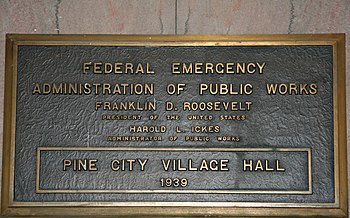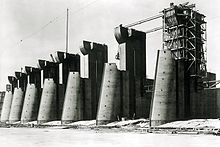The Public Works Administration (PWA) helped make improvements to what part of the nations economy?

Federal Emergency Assistants of Public Works project plaque in the Pino City, Minnesota Urban center Hall

Public Works Assistants (PWA), part of the New Deal of 1933, was a large-scale public works construction agency in the United States headed by Secretary of the Interior Harold L. Ickes. It was created by the National Industrial Recovery Act in June 1933 in response to the Cracking Depression. It built large-scale public works such every bit dams, bridges, hospitals, and schools. Its goals were to spend $3.three billion (about $10 per person in the U.S.) in the first year, and $vi billion (virtually $xviii dollars per person in the U.South.) in all, to supply employment, stabilize buying ability, and aid revive the economic system. Most of the spending came in two waves in 1933–35, and over again in 1938. Originally called the Federal Emergency Administration of Public Works, it was renamed the Public Works Administration in 1935 and shut downward in 1944.[ane]
The PWA spent over $7 billion (near $22 dollars per person in the U.S.) on contracts with private construction firms that did the bodily work. It created an infrastructure that generated national and local pride in the 1930s and is even so vital viii decades afterwards. The PWA was much less controversial than its rival agency with a confusingly similar name, the Works Progress Assistants (WPA), headed past Harry Hopkins, which focused on smaller projects and hired unemployed unskilled workers.[two]
Origins [edit]
Frances Perkins had first suggested a federally financed public works program, and the idea received considerable support from Harold L. Ickes, James Farley, and Henry Wallace. After having scaled back the initial price of the PWA, Franklin Delano Roosevelt agreed to include the PWA as function of his New Deal proposals in the "Hundred Days" of bound 1933.[3]
Projects [edit]

PWA-funded construction site in Washington, D.C. in 1933
The PWA headquarters in Washington planned projects, which were built past private construction companies hiring workers on the open marketplace. Unlike the WPA, information technology did not hire the unemployed straight. More than whatever other New Deal program, the PWA epitomized the progressive notion of "priming the pump" to encourage economic recovery. Between July 1933 and March 1939, the PWA funded and administered the construction of more than 34,000 projects including airports, big electricity-generating dams, major warships for the Navy, and bridges and 70% of the new schools and one-tertiary of the hospitals congenital-in 1933–1939.
Streets and highways were the almost common PWA projects, as xi,428 route projects, or 33% of all PWA projects, accounting for over 15% of its total upkeep. School buildings, 7,488 in all, came in 2d at fourteen% of spending. PWA functioned chiefly by making allotments to the diverse Federal agencies; making loans and grants to state and other public bodies; and making loans without grants (for a brief time) to the railroads. For example, it provided funds for the Indian Partition of the CCC to build roads, bridges, and other public works on and near Indian reservations.

Fort Peck Dam in Montana; spillway construction. 1 of the largest dams in the world, information technology continues to generate electricity; in July 1936 its construction employed x,500 workers.
The PWA became, with its "multiplier-result" and a get-go ii-year budget of $3.3 billion (compared to the entire Gdp of $60 billion), the driving force of America'southward biggest construction attempt up to that date. By June 1934, the bureau had distributed its entire fund to 13,266 federal projects and two,407 non-federal projects. For every worker on a PWA project, nearly two additional workers were employed indirectly. The PWA accomplished the electrification of rural America, the building of canals, tunnels, bridges, highways, streets, sewage systems, and housing areas, too as hospitals, schools, and universities; every yr it consumed roughly half of the concrete and a third of the steel of the entire nation.[iv] The PWA too electrified the Pennsylvania Railroad between New York and Washington, DC.[5] At the local level it built courthouses, schools, hospitals and other public facilities that remain in utilize in the 21st century.[half-dozen]
List of virtually notable PWA projects [edit]
- Lincoln Tunnel in New York City
- Bankhead Tunnel in Mobile, Alabama
H2o/Wastewater [edit]
- Detroit Sewage Disposal Project
Bridges [edit]
- Overseas Highway connecting Key West, Florida, to the mainland
- Triborough Bridge
- Greatcoat Cod Canal Railroad Bridge
- Bourne Bridge
- Sagamore Span
Dams [edit]
- Fort Peck Dam
- Hoover Dam
- Grand Canyon Dam in Washington state
- Pensacola Dam[seven]
- Mansfield Dam[8]
- Tom Miller Dam[nine]
- Upper Mississippi River locks and dams[x] [xi]
Airports [edit]
- List of New Bargain airports
Housing [edit]
The PWA was the centerpiece of the New Deal program for building public housing for the poor people in cities. Yet it did not create as much affordable housing as supporters would have hoped, building simply 29,000 units in 4+ 1⁄2 years.[12]
The PWA constructed the Williamsburg Houses in Brooklyn, NY, ane of the first public housing projects in New York City.[13]
Criticism [edit]
The PWA spent over $6 billion simply did not succeed in returning the level of industrial activity to pre-low levels.[14] [15] Though successful in many aspects, information technology has been acknowledged that the PWA'south objective of constructing a substantial number of quality, affordable housing units was a major failure.[14] [xv] Some have argued that because Roosevelt was opposed to arrears spending, at that place was not enough money spent to help the PWA achieve its housing goals.[14] [15]
Reeves (1973) argues that Roosevelt's competitive theory of administration proved to exist inefficient and produced delays. The competition over the size of expenditure, the selection of the administrator, and the appointment of staff at the state level, led to delays and the ultimate failure of PWA every bit a recovery instrument. As director of the budget, Lewis Douglas overrode the views of leading senators in reducing appropriations to $3.five billion and in transferring much of that money to other agencies instead of their own specific appropriations. The cautious and penurious Ickes won out over the more than imaginative Hugh S. Johnson as chief of public works assistants. Political competition betwixt rival Democratic state organizations and betwixt Democrats and Progressive Republicans led to delays in implementing PWA efforts on the local level. Ickes instituted quotas for hiring skilled and unskilled blackness people in construction financed through the Public Works Administration (PWA). Resistance from employers and unions was partially overcome by negotiations and implied sanctions. Although results were ambiguous, the program helped provide African Americans with employment, especially among unskilled workers.[16]
Termination [edit]
When President Franklin D. Roosevelt moved industry toward World State of war II production, the PWA was abolished and its functions were transferred to the Federal Works Agency in June 1943.[17]
Contrast with WPA [edit]
The PWA should not exist confused with its nifty rival the Works Progress Administration (WPA), though both were role of the New Bargain. The WPA, headed by Harry Hopkins, engaged in smaller projects in close cooperation with local governments—such as building a urban center hall or sewers or sidewalks. The PWA projects were much larger in telescopic, such as behemothic dams. The WPA hired only people on relief who were paid direct by the federal government. The PWA gave contracts to individual firms that did all the hiring on the individual sector job market place. The WPA also had youth programs (the NYA), projects for women, and fine art projects that the PWA did not have.[18] [ page needed ]
Notes [edit]
- ^ National Archive. "Records of the Public Works Administration". 135.1.
- ^ Smith (2006)
- ^ Watkins (1990)
- ^ George McJimsey, The Presidency of Franklin Delano Roosevelt (2000) "PWA (1939)", p 221;
- ^ "P.R.R. Will SPEND $77,000,000 AT In one case; Atterbury Outlines Projects Nether PWA Loan Giving Year's Work to 25,000. TO EXTEND ELECTRIC LINE Sees Buying Power Restored and Industry Stimulated by Wide Building Program", The New York Times, January 31, 1934, retrieved 2012-08-08
- ^ Lowry (1974)
- ^ "Pensacola Dam - Grand Lake OK - Living New Deal". 26 March 2015. Archived from the original on 26 March 2015. Retrieved 26 September 2017.
{{cite web}}: CS1 maint: bot: original URL status unknown (link) - ^ ""New Deal Work Programs in Fundamental Texas"". 26 March 2015. Retrieved 13 December 2018.
- ^ "Tom Miller Dam - Austin TX - Living New Deal". 26 March 2015. Archived from the original on 26 March 2015. Retrieved 26 September 2017.
{{cite web}}: CS1 maint: bot: original URL status unknown (link) - ^ "Upper Mississippi River Dam - Winona MN - Living New Deal". 26 March 2015. Archived from the original on 26 March 2015. Retrieved 26 September 2017.
{{cite web}}: CS1 maint: bot: original URL status unknown (link) - ^ "Rivers of Life: History of Transportation, function 3". Cgee.hamline.edu . Retrieved 2016-12-09 .
- ^ Hunt (1997); Cam (1939)
- ^ "Williamsburg Housing Development - Brooklyn NY". Living New Deal . Retrieved 2019-10-21 .
- ^ a b c Graham
- ^ a b c Leuchtenburg
- ^ Kruman
- ^ "Executive Gild 9357 - Transferring the Functions of the Public Works Administration to the Federal Works Agency." June thirty, 1943. John T. Woolley and Gerhard Peters, The American Presidency Projection. Santa Barbara, CA: the University of California (hosted), Gerhard Peters (database); Olson, James Stuart. Historical Dictionary of the Great Depression, 1929–1940. Santa Barbara, Calif.: Greenwood Publishing Group, 2001. ISBN 0-313-30618-iv
- ^ Nick Taylor, American-made: The enduring legacy of the WPA (2008).
References [edit]
- Ickes, Harold 50. Back to Work: The Story of PWA (1935)
- Ickes, Harold L. "The Place of Housing in National Rehabilitation," Journal of Land & Public Utility Economic science, Vol. xi, No. 2 (May 1935), pp. 109–116 in JSTOR
- PWA, America Builds. The Tape of PWA. 1939 online edition
Further reading [edit]
- Cam, Gilbert A. "United States Regime Action in Low-Cost Housing, 1932-38," Periodical of Political Economy, Vol. 47, No. 3 (Jun. 1939), pp. 357–378; in JSTOR
- Clarke, Jeanne Nienaber. Roosevelt's Warrior: Harold L. Ickes and the New Deal. 1996. 414 pp.
- Hunt, D. Bradford. "America: Lost Opportunities," Reviews in American History, Vol. 25, No. 4 (Dec. 1997), pp. 637–642 in JSTOR on public housing
- Kruman, Marie W. "Quotas for Blacks: the Public Works Assistants and the Blackness Construction Worker." Labor History 1975 xvi(ane): 37–51. ISSN 0023-656X Fulltext: in Ebsco
- Lowry, Charles B. "The PWA in Tampa: A Case Study," Florida Historical Quarterly, Vol. 52, No. iv (Apr. 1974), pp. 363–380 in JSTOR
- Reeves, William D. "PWA and Competitive Assistants in the New Bargain." Journal of American History 1973 60(two): 357–372. in JSTOR
- Smith, Jason Scott. Building New Bargain Liberalism: The Political Economic system of Public Works, 1933–1956 (2006), the major scholarly study
- Watkins, T. H. Righteous Pilgrim: The Life and Times of Harold L. Ickes, 1874–1952. (1990). 1010 pp. biography
- Graham, Otis L., Jr., and Meghan Robinson Wander, eds. Franklin D. Roosevelt, His Life and Times. New York: Da Capo Press, 1985, pp. 336–337.
- Leuchtenburg, William E. Franklin D Roosevelt and the New Bargain. New York: Harper & Row, 1963, pp. 133–34.
External links [edit]
- The by: Public Works Administration builds housing (PWA housing in Texas)
- Public Works Administration projects list
Source: https://en.wikipedia.org/wiki/Public_Works_Administration
0 Response to "The Public Works Administration (PWA) helped make improvements to what part of the nations economy?"
Post a Comment